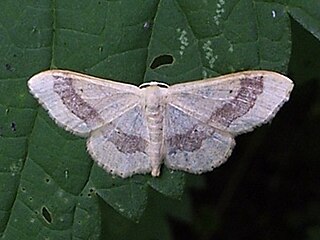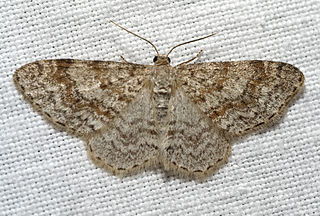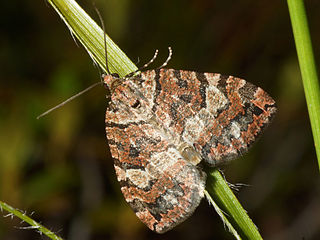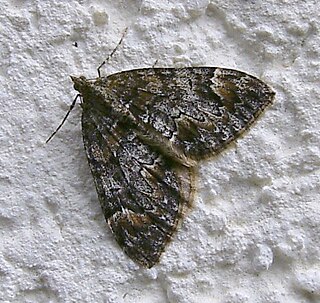
The small fan-footed wave is a moth of the family Geometridae. The species was first described by Johann Siegfried Hufnagel in 1767.

The riband wave is a moth of the family Geometridae. The species was first described by Carl Linnaeus in his 1758 10th edition of Systema Naturae.

The common pug is a moth of the family Geometridae. It is a common species across the Palearctic region, including the Near East and North Africa. It ranges from the Atlantic coast of Ireland and Portugal across Europe, the Middle East and Central Asia to the Russian Far East (Priamurje) and Korea.

Chloroclysta siterata, the red-green carpet, is a moth in the family Geometridae. The species was first described by Johann Siegfried Hufnagel in 1767.

Colostygia pectinataria, the green carpet, is a Palearctic moth of the genus Colostygia in the family Geometridae. It was first described by August Wilhelm Knoch in 1781.

Idaea dimidiata, the single-dotted wave, is a moth of the family Geometridae. It is a Holarctic species.

Ecliptopera silaceata, the small phoenix, is a species of moth in the family Geometridae. The species was first described by Michael Denis and Ignaz Schiffermüller in 1775.

Idaea straminata, the plain wave, is a moth of the family Geometridae. It is found in Europe including West Russia and Balkans.

Idaea subsericeata, the satin wave, is a moth of the family Geometridae. The species was first described by Adrian Hardy Haworth in 1809. It is found from central and southern Europe, North Africa, Asia Minor to Transcaspia.

Eupithecia tantillaria, the dwarf pug, is a moth of the family Geometridae. It was described by Jean Baptiste Boisduval in 1840. The species can be found in the Palearctic realm.

Dyscia fagaria, the grey scalloped bar, is a moth of the family Geometridae. The species was first described by Carl Peter Thunberg in 1784 and it can be found in Europe.

Hydrelia sylvata, the waved carpet, is a moth of the family Geometridae. It is found throughout the temperate parts of the Palearctic realm.

Hydriomena furcata, the July highflyer, is a moth of the family Geometridae. The species was first described by Carl Peter Thunberg in 1784. It is found in the Holarctic ecozone.

Cleora cinctaria, the ringed carpet, is a moth of the family Geometridae. The species was first described by Michael Denis and Ignaz Schiffermüller in 1775. It is found from Europe to southern Siberia, Turkey, the Caucasus, central Asia and Mongolia. It is also found in Japan.

Mesotype didymata, the twin-spot carpet, is a moth of the family Geometridae. The species was first described by Carl Linnaeus in his 1758 10th edition of Systema Naturae. Its genus is sometimes included in Perizoma.

Dysstroma citrata, the dark marbled carpet or northern marbled carpet, is a moth of the family Geometridae. The species was first described by Carl Linnaeus in 1761. It is found across the Holarctic ecozone and has been reported from India.

Chloroclysta miata, the autumn green carpet, is a moth of the family Geometridae. The species was first described by Carl Linnaeus in his 1758 10th edition of Systema Naturae. It is found from most of Europe to the Alatau in Central Asia.

Colostygia olivata, the beech-green carpet, is a moth of the family Geometridae. It was first described by Michael Denis and Ignaz Schiffermüller in 1775 and it is found in most of the Palearctic.

Epirrhoe galiata, the galium carpet, is a moth of the family Geometridae.

Eupithecia valerianata, the valerian pug, is a moth of the family Geometridae. The species was first described by Jacob Hübner in 1813. It is found from Great Britain, through central Europe to western Russia, Belarus and northern Iran.





















